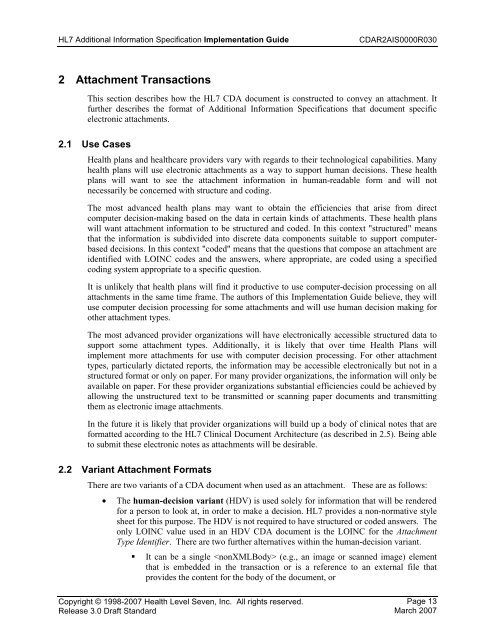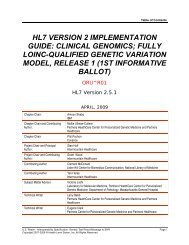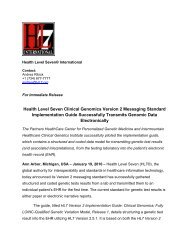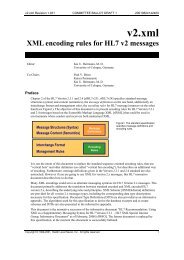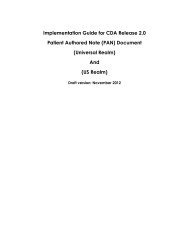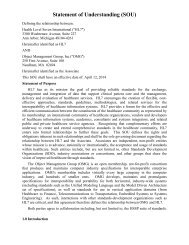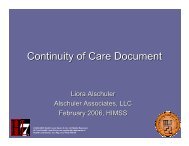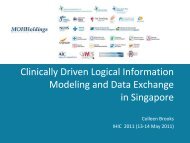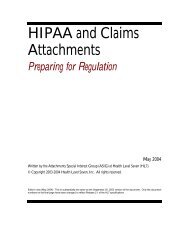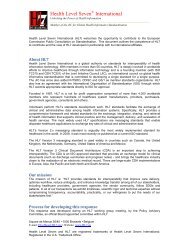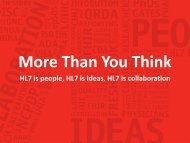HL7 CDA R2 AIS Implementation Guide
HL7 CDA R2 AIS Implementation Guide
HL7 CDA R2 AIS Implementation Guide
You also want an ePaper? Increase the reach of your titles
YUMPU automatically turns print PDFs into web optimized ePapers that Google loves.
<strong>HL7</strong> Additional Information Specification <strong>Implementation</strong> <strong>Guide</strong><strong>CDA</strong><strong>R2</strong><strong>AIS</strong>0000R0302 Attachment TransactionsThis section describes how the <strong>HL7</strong> <strong>CDA</strong> document is constructed to convey an attachment. Itfurther describes the format of Additional Information Specifications that document specificelectronic attachments.2.1 Use CasesHealth plans and healthcare providers vary with regards to their technological capabilities. Manyhealth plans will use electronic attachments as a way to support human decisions. These healthplans will want to see the attachment information in human-readable form and will notnecessarily be concerned with structure and coding.The most advanced health plans may want to obtain the efficiencies that arise from directcomputer decision-making based on the data in certain kinds of attachments. These health planswill want attachment information to be structured and coded. In this context "structured" meansthat the information is subdivided into discrete data components suitable to support computerbaseddecisions. In this context "coded" means that the questions that compose an attachment areidentified with LOINC codes and the answers, where appropriate, are coded using a specifiedcoding system appropriate to a specific question.It is unlikely that health plans will find it productive to use computer-decision processing on allattachments in the same time frame. The authors of this <strong>Implementation</strong> <strong>Guide</strong> believe, they willuse computer decision processing for some attachments and will use human decision making forother attachment types.The most advanced provider organizations will have electronically accessible structured data tosupport some attachment types. Additionally, it is likely that over time Health Plans willimplement more attachments for use with computer decision processing. For other attachmenttypes, particularly dictated reports, the information may be accessible electronically but not in astructured format or only on paper. For many provider organizations, the information will only beavailable on paper. For these provider organizations substantial efficiencies could be achieved byallowing the unstructured text to be transmitted or scanning paper documents and transmittingthem as electronic image attachments.In the future it is likely that provider organizations will build up a body of clinical notes that areformatted according to the <strong>HL7</strong> Clinical Document Architecture (as described in 2.5). Being ableto submit these electronic notes as attachments will be desirable.2.2 Variant Attachment FormatsThere are two variants of a <strong>CDA</strong> document when used as an attachment. These are as follows:• The human-decision variant (HDV) is used solely for information that will be renderedfor a person to look at, in order to make a decision. <strong>HL7</strong> provides a non-normative stylesheet for this purpose. The HDV is not required to have structured or coded answers. Theonly LOINC value used in an HDV <strong>CDA</strong> document is the LOINC for the AttachmentType Identifier. There are two further alternatives within the human-decision variant.• It can be a single (e.g., an image or scanned image) elementthat is embedded in the transaction or is a reference to an external file thatprovides the content for the body of the document, orCopyright © 1998-2007 Health Level Seven, Inc. All rights reserved.Release 3.0 Draft StandardPage 13March 2007


